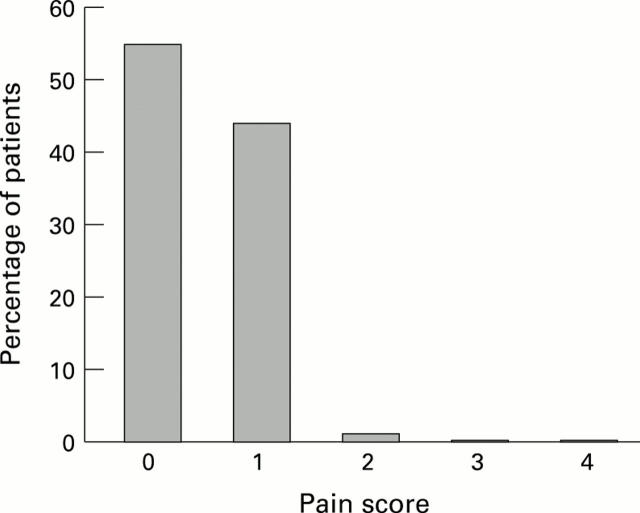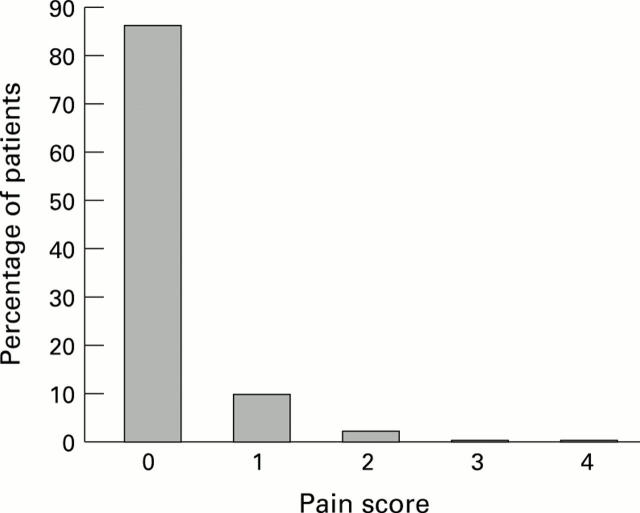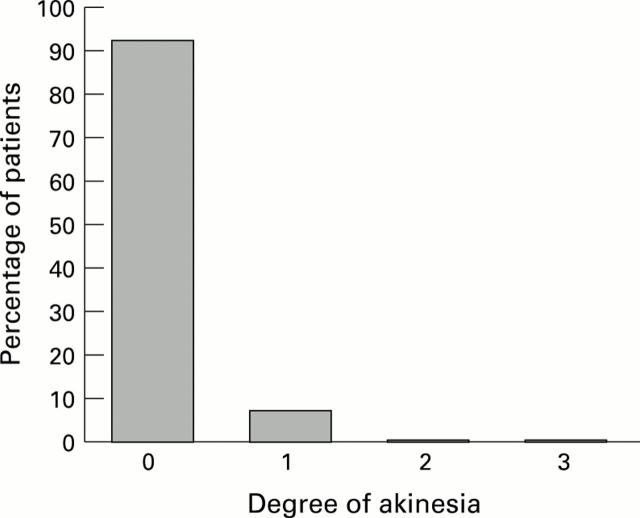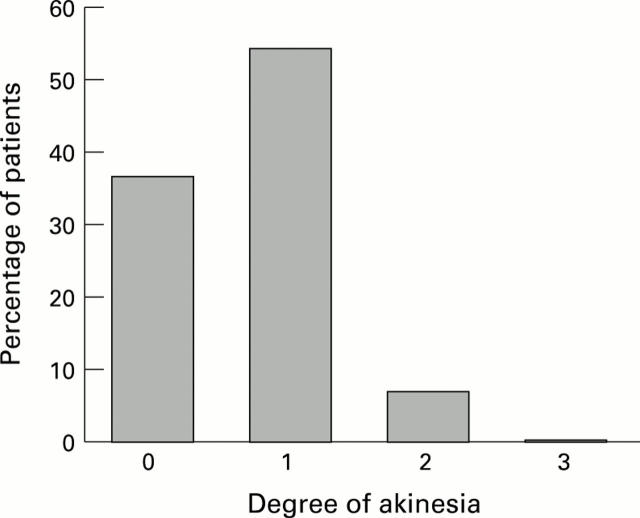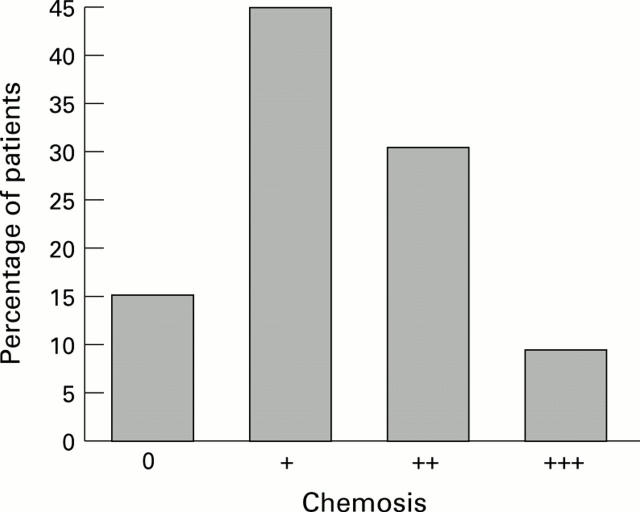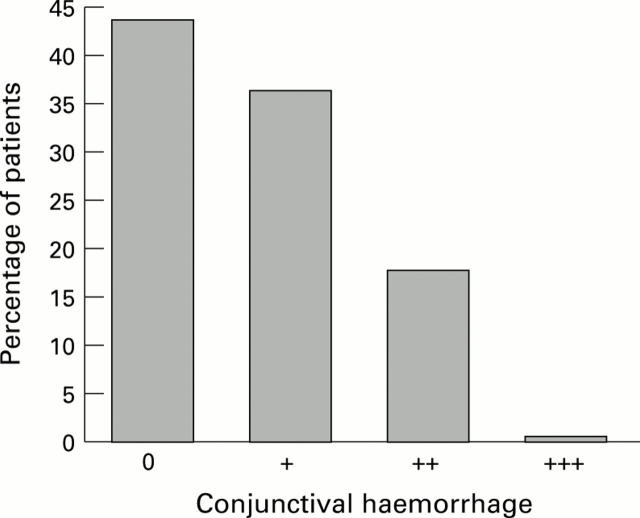Abstract
AIM—To evaluate sub-Tenon' s anaesthesia as an alternative to peribulbar anaesthesia. METHODS—109 consecutive patients listed for various eye operations (including cataract, trabeculectomy, and vitrectomy) under peribulbar anaesthesia were operated on under sub-Tenon's anaesthesia instead. After topical anaesthesia a buttonhole was fashioned through the conjunctiva and Tenon's capsule 10 mm posterior to the limbus. 1.5 ml of lignocaine 2% was then delivered to the posterior sub-Tenon's space using a blunt cannula. The surgical procedure was performed immediately after the completion of the anaesthetic procedure. Chemosis, conjunctival haemorrhage, degree of akinesia, and pain scoring were analysed. RESULTS—There were no anaesthesia related complications. The administration of the block was painless for 99.1% of the patients. In all, 97.3% reported no pain during surgery. There was no akinesia when assessed just after the completion of the block and akinesia was limited when assessed after surgery. Chemosis and conjunctival haemorrhage were frequent but caused no intraoperative problems. CONCLUSION—Sub-Tenon's anaesthesia is an efficient and safe anaesthetic technique. It is a good alternative to peribulbar anaesthesia.
Full Text
The Full Text of this article is available as a PDF (99.6 KB).
Figure 1 .
Pain scoring for the delivery of the sub-Tenon's anaesthetic procedure (0 = no pain, no sensation; 1 = slight `sensation' or discomfort but no pain; 2 = slight pain; 3 = moderate pain; 4 = intense pain).
Figure 2 .
Pain scoring recorded for the operative procedure (0 = no pain, no sensation; 1 = slight `sensation' or discomfort but no pain; 2 = slight pain; 3 = moderate pain; 4 = intense pain).
Figure 3 .
Degree of akinesia just after sub-Tenon's anaesthesia (0 = complete movement remaining; 1 = moderate movement, 2 = slight movement, and 3 = no movement).
Figure 4 .
Degree of akinesia at the end of surgery (0 = complete movement remaining, 1 = moderate movement, 2 = slight movement, and 3 = no movement).
Figure 5 .
Chemosis (0 = no chemosis; + = chemosis involving one quadrant; ++ = chemosis involving two quadrants; +++ = chemosis involving three or four quadrants).
Figure 6 .
Conjunctival haemorrhage (0 = no haemorrhage; + = haemorrhage involving one quadrant; ++ = haemorrhage involving two quadrants; +++ = haemorrhage involving three or four quadrants).
Selected References
These references are in PubMed. This may not be the complete list of references from this article.
- Anderson C. J. Subconjunctival anesthesia in cataract surgery. J Cataract Refract Surg. 1995 Jan;21(1):103–105. doi: 10.1016/s0886-3350(13)80488-9. [DOI] [PubMed] [Google Scholar]
- Davis D. B., 2nd, Mandel M. R. Efficacy and complication rate of 16,224 consecutive peribulbar blocks. A prospective multicenter study. J Cataract Refract Surg. 1994 May;20(3):327–337. doi: 10.1016/s0886-3350(13)80586-x. [DOI] [PubMed] [Google Scholar]
- Duker J. S., Belmont J. B., Benson W. E., Brooks H. L., Jr, Brown G. C., Federman J. L., Fischer D. H., Tasman W. S. Inadvertent globe perforation during retrobulbar and peribulbar anesthesia. Patient characteristics, surgical management, and visual outcome. Ophthalmology. 1991 Apr;98(4):519–526. doi: 10.1016/s0161-6420(91)32262-0. [DOI] [PubMed] [Google Scholar]
- Friedberg M. A., Palmer R. M. A new technique of local anesthesia for panretinal photocoagulation. Ophthalmic Surg. 1991 Oct;22(10):619–621. [PubMed] [Google Scholar]
- Fukasaku H., Marron J. A. Pinpoint anesthesia: a new approach to local ocular anesthesia. J Cataract Refract Surg. 1994 Jul;20(4):468–471. doi: 10.1016/s0886-3350(13)80186-1. [DOI] [PubMed] [Google Scholar]
- Greenbaum S. Parabulbar anesthesia. Am J Ophthalmol. 1992 Dec 15;114(6):776–776. doi: 10.1016/s0002-9394(14)74066-8. [DOI] [PubMed] [Google Scholar]
- Hamilton R. C. Brain-stem anesthesia as a complication of regional anesthesia for ophthalmic surgery. Can J Ophthalmol. 1992 Dec;27(7):323–325. [PubMed] [Google Scholar]
- Hansen E. A., Mein C. E., Mazzoli R. Ocular anesthesia for cataract surgery: a direct sub-Tenon's approach. Ophthalmic Surg. 1990 Oct;21(10):696–699. [PubMed] [Google Scholar]
- Javitt J. C., Addiego R., Friedberg H. L., Libonati M. M., Leahy J. J. Brain stem anesthesia after retrobulbar block. Ophthalmology. 1987 Jun;94(6):718–724. doi: 10.1016/s0161-6420(87)33389-5. [DOI] [PubMed] [Google Scholar]
- Kershner R. M. Topical anesthesia for small incision self-sealing cataract surgery. A prospective evaluation of the first 100 patients. J Cataract Refract Surg. 1993 Mar;19(2):290–292. doi: 10.1016/s0886-3350(13)80958-3. [DOI] [PubMed] [Google Scholar]
- Klein M. L., Jampol L. M., Condon P. I., Rice T. A., Serjeant G. R. Central retinal artery occlusion without retrobulbar hemorrhage after retrobulbar anesthesia. Am J Ophthalmol. 1982 May;93(5):573–577. doi: 10.1016/s0002-9394(14)77371-4. [DOI] [PubMed] [Google Scholar]
- Mein C. E., Woodcock M. G. Local anesthesia for vitreoretinal surgery. Retina. 1990;10(1):47–49. [PubMed] [Google Scholar]
- Metrikin D. C., Anand R. Intravitreal drug administration with depot devices. Curr Opin Ophthalmol. 1994 Jun;5(3):21–29. doi: 10.1097/00055735-199406000-00005. [DOI] [PubMed] [Google Scholar]
- Petersen W. C., Yanoff M. Complications of local ocular anesthesia. Int Ophthalmol Clin. 1992 Fall;32(4):23–30. doi: 10.1097/00004397-199223000-00002. [DOI] [PubMed] [Google Scholar]
- Puustjärvi T., Purhonen S. Permanent blindness following retrobulbar hemorrhage after peribulbar anesthesia for cataract surgery. Ophthalmic Surg. 1992 Jul;23(7):450–452. [PubMed] [Google Scholar]
- Roman S., Pietrini D., Auclin F., Keller M., Ullern M. Phacoemulsification et anesthesie topique. A propos de 40 cas. J Fr Ophtalmol. 1996;19(1):32–38. [PubMed] [Google Scholar]
- Steele M. A., Lavrich J. B., Nelson L. B., Koller H. P. Sub-Tenon's infusion of local anesthetic for strabismus surgery. Ophthalmic Surg. 1992 Jan;23(1):40–43. [PubMed] [Google Scholar]
- Stevens J. D. A new local anesthesia technique for cataract extraction by one quadrant sub-Tenon's infiltration. Br J Ophthalmol. 1992 Nov;76(11):670–674. doi: 10.1136/bjo.76.11.670. [DOI] [PMC free article] [PubMed] [Google Scholar]
- Stevens J. D., Franks W. A., Orr G., Leaver P. K., Cooling R. J. Four-quadrant local anaesthesia technique for vitreoretinal surgery. Eye (Lond) 1992;6(Pt 6):583–586. doi: 10.1038/eye.1992.126. [DOI] [PubMed] [Google Scholar]
- Wylie J., Henderson M., Doyle M., Hickey-Dwyer M. Persistent binocular diplopia following cataract surgery: aetiology and management. Eye (Lond) 1994;8(Pt 5):543–546. doi: 10.1038/eye.1994.134. [DOI] [PubMed] [Google Scholar]



